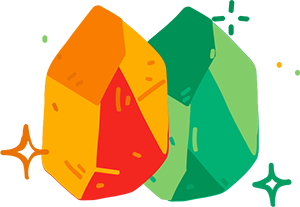Introduction to the InnoMojo
Co-creation has been an essential element of Innovation for Change – it’s DNA – since the very beginnings of the network in 2015. Starting as a civil society owned and led network, we responded to worsening trends affecting civic space and civil society in the Global South. The continued focus on applying innovative methodologies and frameworks, especially design thinking (DT) methods led to a lot of learnings, experiments and prototypes for our communities. After applying different co-creation methodologies in different contexts, we developed our own understanding and application of the so-called codesign, that gave the most innovative and rooted solutions in many different corners of the world.
The idea for InnoMojo: The Spellbook for Social Change was born in 2020, at one of the regular bi-weekly calls of I4C’s Innovation Working Group (IWG) where innovation officers from all 7 regions came together to share insights and experiences related to codesign and other innovation processes in their I4C Hubs. Being involved in more than 50 codesign processes, as a working group, we realized that sharing and capturing our experiences, questions, failures and learnings will be useful for anyone else outside this IWG and it will contribute to growing our evolving knowledge of applying design thinking methodology to social change. Taking into consideration few existing resources on DT that are focused on social change and impact (and there are not many, btw!):
we decided to create an online “practice toolbox”, or more like a “book of spells” where we capture the nitty-gritty details of doing codesign almost in every corner of the world, and sharing the most practical tips and tricks from our lived experiences as participants, organizers and facilitators of codesign sessions dedicated to civil society.
The culture of co-design + co-creation
What is Design Thinking?
Design Thinking is a process for creative problem solving. It puts people at the centre of the process of coming up with solutions to problems or needs that they have. This is often called the human- or user-centered approach. It encourages us as NGOs, movements and networks to focus on and work with the people who are affected by a problem when creating potential solutions, whether that’s a campaign, product or service. Understanding how people are affected and what their needs are and respecting local and Indingeous knowledge can lead to better solutions.
Thinking Like A Designer
Design Thinking encourages us to think like a designer:
The core of co-design is bringing people from different backgrounds. Different power dynamics and getting them to work collectively, creatively, together and thoughtfully is what makes codesign so special. So the best of every participant can and should be used in the design process.
Bringing a diverse group of people together, people who are affected by the issue, people with the skills, different backgrounds, different perspectives and different ages creates special conditions to unleash innovation and collaboration. So, applying this in civil society is important because we have respect and curiosity for different perspectives and disciplines, whether you’re coming from research or technology development, from legal advocacy or community mobilisation and indeed it gives us all an opportunity to find ways to collaborate with people of the same values or similar values.

Co-design is all about people doing the work together and it’s unleashing the power of diverse thinking. So if people who are experiencing the issue or challenge, whatever that may, be come together, they often have their own solutions, and if you build something together, then the chances of the successes of what you build, whether that’s adopting a campaign or using a piece of tech, it’s often far greater. And what we were finding is it also reduces the risk of wasting time and money on creating a campaign or website that nobody engages with or uses.

And the journey has been painful. It hasn’t been a, you know, it’s not all Kumbaya and let’s hold hands and things will get done. Co-design, by its very definition, means it’s chaotic. It means that egos battle it out. And, ultimately, the product that comes out of the process, if the process has been done appropriately and with all of the parameters that need to be kept in mind in place, it can be a very successful product. But the process is quite something. And it’s not for the faint of heart.

Q5
For me, I think it’s particularly powerful in a civil society context or development context because of the entrenched power dynamics and the fact that, historically, voices from the Global South, voices from human rights activists, voices of women, voices of people of colour have been suppressed, ignored, oppressed. So if you completely reverse your entire methodology and you facilitate listening properly, you can actually understand the root causes and reframe a problem and then actually perhaps design something that’s actually addressing the real problem.

Who is this InnoMojo for?
InnoMojo: the Spellbook for Social Change is a useful toolbox for anyone who is interested or starting their journey into design thinking, codesign and social change. The content is developed in a way that you can follow and make use of it with no prior formal or non-formal education in the field. However, practitioners with experience in codesign will also find something useful in this spellbook, especially for social topics and their relevance in the Global South.
The content of this InnoMojo was developed in a fully co-created process by: Innovation for Change, in collaboration with partners who supported us on this journey.
Glossary of terms
Ooops, we haven’t completed this part yet. But magic can happen while waiting, just go through the following video and text – it might help 🙂
p.s. thanks for your patience
What is Design Thinking?
Design Thinking is a process for creative problem solving. It puts people at the centre of the process of coming up with solutions to problems or needs that they have. This is often called the human- or user-centered approach. It encourages us as NGOs, movements and networks to focus on and work with the people who are affected by a problem when creating potential solutions, whether that’s a campaign, product or service. Understanding how people are affected and what their needs are and respecting local and Indingeous knowledge can lead to better solutions.
Thinking Like A Designer
Design Thinking encourages us to think like a designer:
- Allowing problems and solutions to emerge and develop together
- Adopting a solution-focused way of thinking to find new insights and ideas, break out of our comfort zones and avoid repeating things that are not working
- Creating, testing and trying out solutions before scaling them
Complex Problems
In civil society, we are often trying to tackle very complex problems such as inequality, freedom of expression or climate change. Design Thinking is particularly useful when trying to come up with solutions to complex problems because it embraces the uncertainty that comes with complexity and involves testing solutions to see if they work. One of the great strengths of Design Thinking is that it recognises there are many different ways to solve complex problems. DT enables you to generate lots of ideas, to choose the best and then test and iterate.
The 6 stages of design thinking


From our experience in supporting civil society teams, networks, movements and alliances, when people are learning about Design Thinking, it is often helpful to recognise the similarities between planning tools that we may already know and use, and those that are included at each step in the Design Thinking process.
As an overall approach, Design Thinking may at first seem new. But when we look at each of the six steps in the process, we will very likely see elements that we recognize from our approaches to research, planning and implementation. These include elements of qualitative research, co-design and programme design, testing and monitoring and evaluation.
Design Thinking’s Six Steps:

Gather data about how the people affected by, or involved in the issue, experience it. Effectively you will be doing qualitative research to gather insights about people’s pains, frustrations and goals.
Understand the context and make sense of the various causes and effects of the issue we are examining. Participants will do this by synthesising information, stories and data gathered from the Empathy Stage.
At this stage, we look again at our original challenge statement and reframe or update it using the insights that emerged during the Empathy and Sense-Making Stages. The objective is to ensure the challenge is still relevant after all you have learned.
In this stage you will be generating as many ideas as possible to solve the challenge, pushing your creativity and building off of one another’s ideas.
Prototypes take your best ideas or concepts and make them physical. This could be a storyboard of your campaign journey, a drawing of your website or app and so on.
At the Test Stage, we will launch a finalised campaign or programme and get feedback from a real user of our solution, and so test its impacts. By real-life use, we mean the prototype is refined enough to deliver a programme, product or service to the people affected by an issue or launch and engage people in a campaign. A real user refers to someone who is actually using the product or service, not simply a user representative in a workshop.
Throughout the six steps, out think will either be:
Divergent: Allowing for different insights, ideas and possibilities to emerge; or
Convergent: When we make decisions about the most relevant insight or idea, or ideas merge.
Empathy, Sense-Making & Reframe
The first diamond is about exploring the ‘what’ and ‘why’ of the current situation. It has three steps: Empathy, Sense-Making and Reframe. We start with a problem or challenge. What are the dynamics that are causing the current situation to persist? Why is this important and why is it occurring?
Empathy
Gather data about how the people affected by, or involved in the issue, experience it. Effectively you will be doing qualitative research to gather insights about people’s pains, frustrations and goals
Sense-Making
Understand the context and make sense of the various causes and effects of the issue we are examining. Participants will do this by synthesising information, stories and data gathered from the Empathy Stage.
Reframe
At this stage, we look again at our original challenge statement and reframe or update it using the insights that emerged during the Empathy and Sense-Making Stages. The objective is to ensure the challenge is still relevant after all you have learned.
Ideate, Prototyping & Test
The second diamond is about co-creating new solutions. It has three steps: Ideate, Prototype and Test. we collaborate to develop and deliver new possible solutions that can bring about a positive change.
Ideate
In this stage you will be generating as many ideas as possible to solve the challenge, pushing your creativity and building off of one another’s ideas.
Prototyping & Testing
Prototypes take your best ideas or concepts and make them physical. This could be a storyboard of your campaign journey, a drawing of your website or app and so on.
Test
At the Test Stage, we will launch a finalised campaign or programme and get feedback from a real uer of our solution, and so test its impacts. By real-life use, we mean the prototype is refined enough to deliver a programme, product or service to the people affected by an issue or launch and engage people in a campaign. A real user refers to someone who is actually using the product or service, not simply a user representative in a workshop.
forth between them
one-size-fits-all or perfect way to complete the process
experiences and the values of the methodology, it’s your job as a facilitator to ground the
process as much as possible
Where to start
This InnoMojo is made up of fourteen chapters, all of which contain rich information and knowledge on how to successfully make use of the Design Thinking methodology and co-design tools and strategies. Please be reminded that this is a book of spells and in some way, a living document. Some content might be missing, some content might be changed over time – it is our greatest priority to keep the InnoMojo updated and soon, translated into different languages.
After this introductory chapter, Chapters 2 and 3 get you started on planning and preparing for the Design Thinking process. Chapters 4 and 5 pick up by inviting facilitators and participants and setting them up for the process.
Then, Chapters 6-11 outline and describe the entire Design Thinking process, from the Empathy Stage all the way to the Test Stage. These chapters each provide a brief overview of the relevant stage, list some tools for completing it, share on-the-ground experiences and best practices and conclude with advice for facilitating it in hybrid online/offline settings.
To ensure that the InnoMojo is made even more practical, Chapter 12 takes you through a sample co-design process in the context of the development of a project, programme, product, service and the like. From there, Chapter 13 covers the important step of completing developmental evaluation, ready with tools, best practices and advice for hybrid settings. Finally, Chapter 14 shares testimonies from members and partners surrounding how they’ve integrated Designing Thinking and co-design into their work and, in turn, how the methodology and its tools and strategies have impacted them.
From this InnoMojo, you can expect to learn, in depth, about the Design Thinking methodology and co-design tools and strategies. More than that, though, you’ll receive tips and tricks for completing the Design Thinking process in an engaging, meaningful and human-centered way. Throughout the InnoMojo, we’ve intentionally centered the experiences, reflections and insights of colleagues, members, partners and ‘experts’ so that you can hear, directly from them, their guidance for operationalizing this process. For us, and we hope for you too, this exercise is all about creating a learning community, a community of practice, to build our collective capacities for bringing Design Thinking and co-design to life in the civil society sector.
We invite you to explore the pages of this InnoMojo with openness and curiosity, a readiness to engage and experiment and also a critical and constructive eye. Think about how you can bring your own work to the InnoMojo and also how you can take the InnoMojo to your work. How can you start a dialogue between the two and, even more, a dialogue with us? After all, the spirit of co-design is collaboration, and that’s exactly what this InnoMojo attempts to foster!

